Closing your pool for the winter season is a great practice to get into to keep your pool in top condition. But once you’ve done that, it doesn’t mean your job is done for the season. So, how do you maintain a winterized above-ground pool?
Maintaining your above-ground pool during winter is simple. I recommend weekly checks of the pool body, water, equipment, and water chemistry. However, during freezing temperatures, these checks should be done daily.
As you can see, maintaining your winterized above-ground pool isn’t all too dissimilar to your summertime pool routine. Let’s take a closer look at what you need to do to maintain your above-ground pool in the winter months.
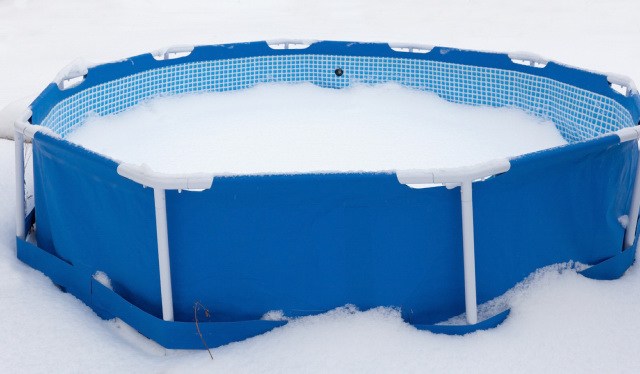
Article Contents
Do You Need to Maintain an Above Ground Pool in Winter?
Whether you decide to fully, or partially drain, or keep the usual water level, maintaining the pool during winter properly will save you a lot of work when it warms up. It may also save you from having to do expensive repairs.
The most common practice when winterizing a pool in cold climates is to drain it partially. Usually to just below the water returns or inlets. Some even fully drain their pools.
Although it’s the most popular, it may not suit your lifestyle and isn’t necessary if you live in mild winter climates.
The winter maintenance required will depend on if you have a partially drained or undrained above-ground pool. Here’s a little more on that…
You’ve Fully Drained and Emptied Your Pool
Some above-ground pool owners will completely drain and dismantle their pools if possible. It can be the easiest option as there’s less stress dealing with potential freeze damage to the pool body. And there won’t be a big mess to clean in Spring.
Although it saves you from worrying about winter maintenance, draining the pool will significantly increase the costs of reopening it come spring/summer. Having to refill the pool and re-establish the correct chemistry levels is incredibly time-consuming as well as expensive.
If you do go this way, it might be time to reconsider what to put under your pool. Having something like a tarp or underlay of some kind will protect the bottom.
Warning: Unless you’re going to pack away your pool, do not completely drain above-ground pools and leave them drained for extended periods of time (like over winter). The empty pool will be vulnerable to winter damage (snow, ice, debris) and the pool liner constricting and tearing from the changing air temperatures.
You’ve Partially Drained and Emptied Your Pool
Partially draining your pool is the best practice in climates that freeze over. Keeping a lower water level will prevent the pool body from suffering wintry conditions. In addition, lowering the water will allow the water to expand into ice.
And if you’ve blown out your pipes properly and drained your pump and filter, then you don’t need to worry about freeze damage there either.
After the initial closing of your pool, if you’ve done it properly, and have installed a pool cover, there is very little maintenance required. You will need to periodically remove the water that’s floating on top of your pool cover though. You can do this with a pool cover pump.
You Haven’t Drained Your Pool
If you live in an area with mild winter conditions (no chance of freezing) then maintaining the normal water level is the way to go.
If this is the case, continue with your usual pool maintenance routine with some changes. Here’s what we recommend:
- You’ll need less chlorine
- Keep the pool covered
- Reduce the pump/filter running time to 4 hours per day
- Keep the pool pH and stabilizer balanced
- For saltwater pools, you may need to add chlorine by hand or with a chlorine floater. Saltwater chlorine generators reduce the chlorine output in low temperatures.
Above Ground Pool Winter Maintenance Schedule
Once you’ve closed your pool for the season, there are a few things to keep in your mind’s eye throughout the winter months. These include properly maintaining the pool cover, checking the pool equipment, and monitoring the water chemistry.
If you’ve yet to winterize your pool or want a refresher on the steps involved, look at our guide, How to Close Above Ground Pool | Easy Way to Winterize, for the best practices.
It can be easy to forget to check over your pool when it’s not in use. However, a good rule of thumb is to inspect your pool at least once a week. And, during freezing conditions, check every day to make sure everything is working correctly and the water isn’t freezing.
Initial Closing
- Close when the temperature is consistently below 65°F (18°C)
- Thoroughly clean the pool (brushing walls, vacuum, and filter), balance chemicals, shock, and add an algaecide.
- Winterize pool pump, heater, filter, and skimmer
- Blow out the pipes and plug
- Put pool cover and pool pillow on
Closing your pool usually starts when temperatures fall below 65°F (18°C). Having the right pool cover protecting your winterized pool can be the difference between opening your pool to crystal clear water or cloudy green water.
To keep your pool cover in tip-top shape, follow these maintenance steps:
Secure Cover: This may seem like an obvious step, but a strong gust of wind on an unsecured cover can ruin all of your winter work. If you’re using air pillows, pop them under the cover. Then, make sure that the cable is tightened and secure the clips.
Every Day Tasks
1. Run Pump 4 Hours Per Day
If you haven’t winterized your pump and filter or partially drained your pool, set the pump to about 4 hours per day. This will keep the water clean and also help to prevent water freezing.
2. Check for Freezing Weather
If you haven’t winterized your pool equipment, you’ll need to keep an eye on the weather. Freezing water will wreak havoc on your pool equipment. So consider using weather alert apps to notify you of impending freezing temperatures so you can prepare your pool’s plumbing.
Or, consider investing in an outdoor thermometer with an alarm. You’ll be able to set minimum temperatures that will sound an alarm so you can prepare your pool for frost.
To help prevent the water from freezing, run the filter and pump 24/7 to keep the water circulating. This will only work for so long. Once it’s cold enough, the water will freeze regardless of if it’s moving or not.
3. Watch for Snow
If you live in an area prone to snow, keep a rake on hand for heavy snowfall. Raking the cover to remove the bulk of the snow is the easiest way to clear it.
4. Remove Excess Water, Snow, and Debris from the Pool Cover
It’s important to keep an eye on your pool cover, Now, this doesn’t mean running out every time some leaves land on the cover.
Instead, check the cover every day or two, and when the cover starts to dip from the weight, use a shop vac or sump pump to remove excess water and debris. Carefully remove any sticks to prevent punctures in the cover.
Weekly & Monthly Tasks
1. Add Chlorine and Check Chemical Balance
Monitoring the pool’s water chemistry during winter will mean it will be much easier and cheaper to open when it warms back up. However, it doesn’t need to be tested as often.
Check your pool’s chemistry every 2-4 weeks to ensure that all the levels are balanced. If you do add chemicals and you have winterized the pump, you’ll need to stir the water with something like a pool brush. This will ensure they are thoroughly mixed through.
2. Visually Check Water Condition
You want to look for cloudy water and algae. Also dirty water.
If the water is dirty or has algae in it, make sure you have the right chlorine level (2-3 ppm). If you’ve been running your pump and filter regularly, your water will likely be pretty clean.
On the other hand, if you have shut down your pump for the winter, there’s not much you can do to clean the water or remove accumulated debris. The only advice is to keep the pool covered and regularly add chlorine and keep it balanced.
3. Maintain the Water Level
If you haven’t drained your pool, keep an eye on the water level. It should be able halfway up the skimmer.
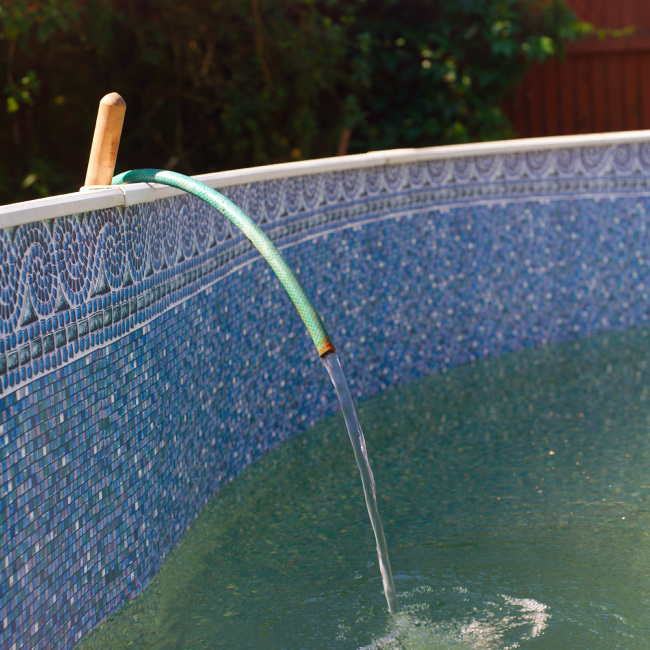
It’s equally important to watch the water level if you have partially drained your pool. Heavy rain or melted snow can increase the water level above the height of the plumbing. You want to keep the water below this. Use a pump to remove excess water.
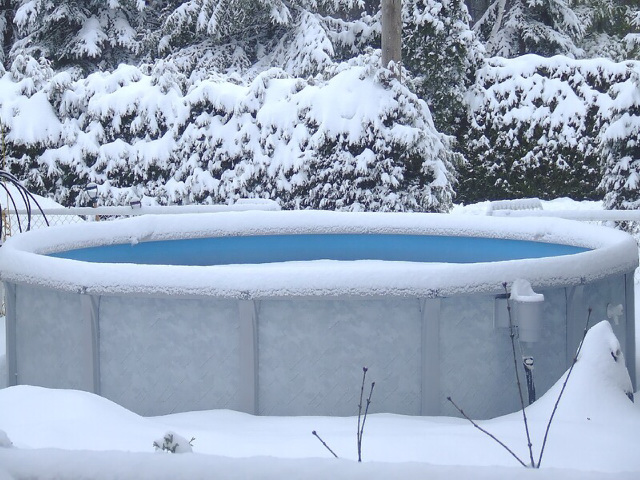
Is Chlorine Necessary During Winter?
Chlorine is still necessary during winter to protect your pool from bacteria and other organic growth, such as algae. However, because the pool isn’t in use, and the temperature is much lower than in summer, less chlorine is needed.
Regardless of if your pool is partially drained and closed or you have opted to maintain the usual water level, adding chlorine on a regular basis is still a good idea.
Although some pool owners have found that it isn’t necessary if they close their pool when temperatures are quite low (near freezing) and reopen when it’s just starting to warm up.
Even though algae and other bacteria tend to slow their growth during the cold months, they are still present and growing. So, I advise you to check your pool every 2 weeks to ensure the chlorine level stays within the 1-3 ppm ideal range.
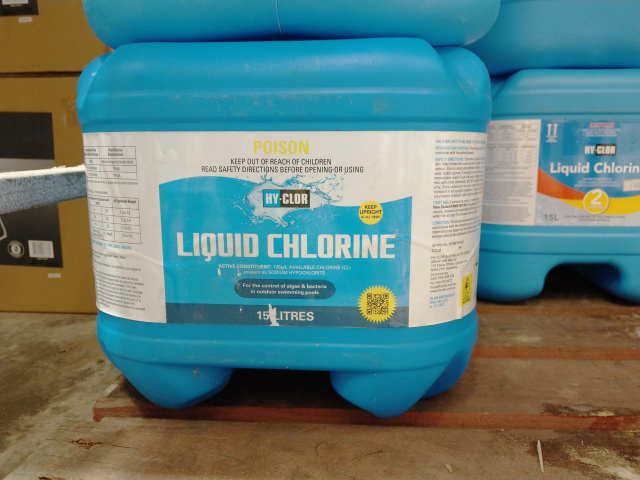
For closed pools, where the water level has been lowered, when you do add chlorine, do not use chlorine tablets. Instead, use liquid chlorine or pre-dissolve granular chlorine and pour it in.
This is important. You’ll also need to agitate the water well with a pool brush since you can’t run your pump to circulate the chlorine. You don’t want a concentrated area of chlorine in your pool.
Should You Shock a Pool in Winter?
Whether to shock your pool during the winter season is debated among pool experts. Although it can be a great headstart when reopening, it can result in staining and damage if done incorrectly.
Shock your pool in winter if:
- Your pool cover is loose-fitting and lets in water and/or sunlight
- You’ve noticed algae or cloudy water
Pools with rigid winter safety covers won’t need as much maintenance and may not need a winter shock. These types of cover prevent sunlight (as well as debris, snow, etc.) from entering and upsetting the water chemistry.
But, if your pool cover is thin or mesh, sunlight, debris, and melted snow/ice will easily get into the pool and disturb the chemistry.
When deciding whether to give your pool a winter shock, the best thing is to test the water for Free Chlorine (sanitizer levels) and inspect the water quality.
If the chlorine level is good and the water looks clear, you don’t need to shock the pool. However, if there is little/no Free Chlorine or the water has a cloudy/green look, adding shock will prevent algae from growing any further.
On shocking, check out our easy-to-follow guide, How To Shock A Swimming Pool For Beginners (In 6 Easy Steps). And, if you’ve winterized your pool equipment, you can circulate the water yourself by vigorously brushing the pool or renting a submersible pump!
If you do shock your pool, make sure you pre-dissolve granular pool shocks before adding them to the water. And for all shocks, make sure you properly circulate the water. Use a pool brush to stir the water if your pump has been winterized. Or run the pump for a few hours if it’s still operational.
Above Ground Saltwater Pool Winter Maintenance
Maintaining a saltwater above-ground pool is very similar to a typical chlorine version. You will still need to maintain the chlorine level but you may have to winterize the saltwater cell and/or add chlorine manually.
At a glance:
- Remove and use a dummy saltwater cell if you live in climates that freeze over.
- Manually add chlorine if you have partially drained and winterized your saltwater generator.
- Manual chlorine additions may be necessary if you haven’t lowered your water level and temperatures drop below 60°F (15.5°C).
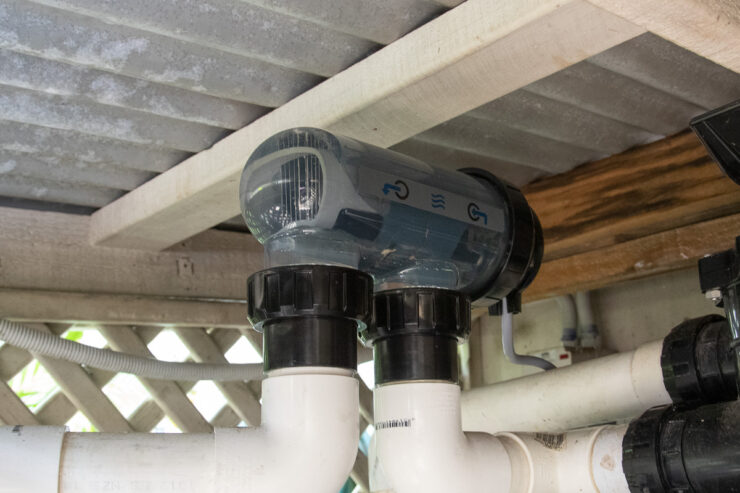
Saltwater pools sanitize the water using a saltwater chlorine generator (SCG). But depending on the generator, they will shut down at temperatures below 60°F (15.5°C). More advanced SCGs have a Winter Mode and will run at a reduced level, generating less chlorine.
Because of this, if you’ve kept the usual water level, you may need to add additional chlorine by hand or use a chlorine floater to maintain chlorine levels of 2-3 ppm.
If you’ve closed and partially drained your pool, then adding chlorine by hand will be necessary.
For those that live in a climate where things freeze over, you need to winterize your saltwater chlorine generator and remove the salt cell. It’s best to thoroughly clean the cell before storing it safely indoors.
And invest in a dummy salt cell like this Pentair cell to ensure the line is sealed throughout the winter.
Should You Run the Pool Filter in Winter?
If you’ve maintained normal water levels in your pool, run your pool filter for about 4 hours daily. If you’ve partially drained your pool, you won’t be able to run your pool filter.
If you haven’t partially drained or lowered the water level in your pool below the skimmer, running the filter daily will keep your pool equipment working smoothly and prevent stagnant water from sitting in the filter and the pool. When temperatures get low, running water is less likely to freeze.
Running the filter will also keep the pool water clean and prevent bacterial and algae growth.
So, when should you run the filter?
It’s best to change the run schedule to during the night and early hours of the morning, as this is when the water is coldest and most likely to freeze. In addition, changing the run time will protect your pool equipment and plumbing.
If you have a variable speed pump, most modern types have a temperature sensor that will automatically run the pump at a low level throughout the night, despite your schedule settings. But, this depends on where you live and if you experience freezing weather conditions.
Do You Need a Pool Cover in Winter?
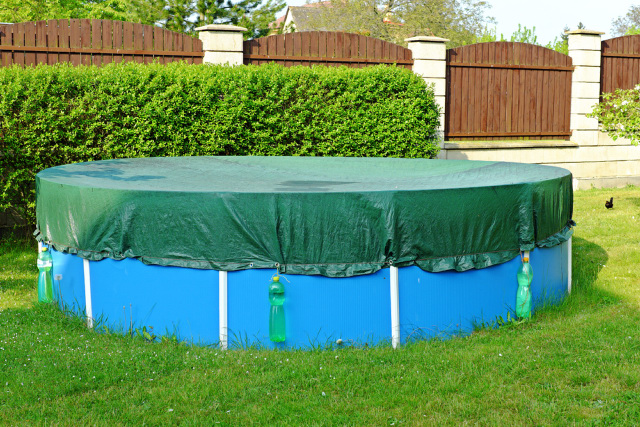
Technically you don’t need a pool cover, especially if you live in a warm winter climate.
However, if you do have freezing winters or don’t use your pool in winter, using a pool cover is recommended. It will keep your pool much, much cleaner. And a cleaner pool means, fewer algae, and fewer problems.
The best type of winter cover is one that fits tightly over a pool and is strapped down. These are called safety covers. They’re great because they keep animals, snow, sunlight, and debris out of your pool.
You can also opt for a solar cover or another type of thin cover. You’ll need to weigh these covers down.
A winter pillow is a good idea too. This will prevent damage to the pool walls if the water freezes. You can read more about winter pool pillows here.
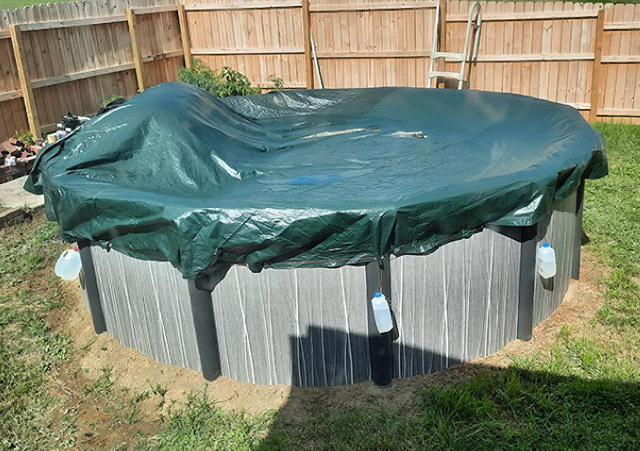
Can An Empty Above-Ground Pool Collapse?
We don’t recommend emptying above-ground pools, as they will likely collapse without the stability that the water provides to weigh them down and maintain their structure.
Without water, you run the risk of the walls collapsing. And in strong winds, the pool could blow away. Causing damage to surrounding property and landscaping.
Can You Use An Automatic Pool Cleaner During Winter?
If you have not drained your pool and/or winterized your pump and filter, an automatic pool cleaner can be used successfully in winter. Robotic pool cleaners can be used regardless of if you have lowered the water level or not.
I would recommend you run your pool cleaner throughout the winter if you do not use a pool cover. Or have a loose-fitting pool cover. It will help to prevent algae and bacterial growth and keep the water cleaner,
Automatic pool cleaners rely on using the pool pump and having sufficient water in the pool to operate. So you’ll only be able to use it if you haven’t partially drained or winterized your pool equipment.
Many pool owners use their robotic pool cleaners without fault during winter. However, some reduce the cleaner’s work hours, whereas others let it complete its usual routine.
In either case, you may need to peel back part of your pool cover, so it doesn’t impede the pool cleaner.



